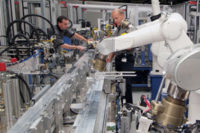US Businesses Are Optimistic and Primed to Spend

Good news! According to a new survey of global businesses conducted by American Express and the Centre for Business and Economic Research (CEBR), U.S. companies are the most bullish and optimistic when it comes to business-to-business (B2B) spending than companies in five other industrialized countries.
The Global Business Spend Indicator (GBSI) survey leverages data from more than 3,600 companies in Australia, Canada, Japan, Mexico, the UK and the U.S. Together, these countries account for two-fifths of global economic output, making the GBSI a key bellwether of conditions in B2B spending. The survey encompasses a similar number of small, medium and large companies in each country and spans a range of industries.
The survey defines B2B spending as goods and services that businesses purchase from another businesses. The survey covers the following B2B spending categories: raw or processed materials; capital investments and operating expenditure; technology; building, construction, maintenance and installation; finished goods; advertising, sales and marketing; business and professional services; utilities; and financial services. Broader business spending categories include taxes and licensing; travel, entertainment and expenses; and workforce.
The survey found that 76 percent of U.S. businesses express optimism about their prospects for the next 12 months. Respondents predicted that B2B spending in the U.S. will be an average of 3.4 percent higher in the second quarter of 2021 compared to the same period last year. Applying that projection to broader U.S. macroeconomic data equates to approximately $140 billion in additional B2B spending from U.S. businesses.
“B2B spending is an important bellwether for the overall health of the economy, and the GBSI study shows U.S. businesses are investing and spending more, whether it’s to adapt to new ways of operating during the pandemic or to digitize and streamline their operations,” says Dean Henry, executive vice president of global commercial services at American Express.
The CEBR estimates that the value of B2B expenditures each year amounts to nearly half of gross output (the total value of sales or receipts) in the U.S. economy. This means that for each dollar spent in the U.S. economy, approximately 48 cents are B2B transactions.
U.S. businesses in the survey reported that they have increased their overall B2B spending across all categories since the start of the year. The highest growth rates were in spending on raw or processed materials, such as lumber, metals and chemicals, which rose by an average of 6.2 percent between the first quarter of 2020 and the first quarter of this year. This equates to an estimated $37 billion in additional spending when applied to U.S. macroeconomic data, most likely due to rising prices of raw materials after the onset of the pandemic. This trend is expected to continue, with U.S. businesses anticipating another 6.4 percent rise in spending in this category in the second quarter.
On the whole, technology spending by U.S. businesses surveyed rose by an average of 4.1 percent from the first quarter of 2020 to the first quarter of 2021, equating to an estimated $25 billion in additional spending when applied to U.S. macroeconomic data.
The pandemic forced many businesses to streamline their operations and seek more flexible ways to manage their supply chains. Over the past 12 months, 23 percent of U.S. businesses took steps to simplify their network of suppliers; 23 percent reduced or avoided long-term commitments to purchase from specific suppliers; and 22 percent chose suppliers with more flexible payment terms.
Over the next 12 months, U.S. businesses cite increasing profitability (34 percent), securing new business (32 percent), and remaining competitive (31 percent) as being among their three most important goals.
In short, U.S. businesses are spending more. They are investing in automation. And, they are consolidating their supply chains. Let’s put the pandemic behind us and get back to work!
Looking for a reprint of this article?
From high-res PDFs to custom plaques, order your copy today!





